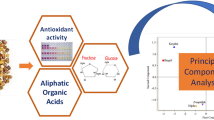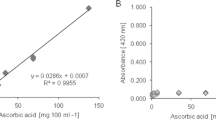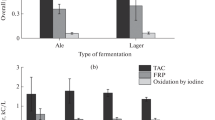Abstract
Recent studies have confirmed the possibility of an insoluble material to carry out a marked antioxidant activity by a solid–liquid interaction, and in such way opened a new chapter for dietary fiber application in food industry as a functional unit with radical scavenging capacity. Therefore, this paper investigates the possibility of improving the antioxidant activity of cookies with addition of sugar beet fibers. The chemometric analysis was carried out on the experimentally obtained data of the antioxidant activity of the cookies with modified and non-modified sugar beet fibers compared to the cookies with commercially available dietary fiber (Fibrex®) produced in the Nordic Sugar A/S factory, Sweden. The hierarchical cluster analysis and the sum of ranking differences were applied. The introduction of modified and non-modified sugar beet fibers in the cookies formulation showed promising results regarding the cookies EC50 values decline compared to the control samples. Cookies with addition of modified sugar beet fibers showed the best antioxidant activity in the first 4 weeks. Cookies with Fibrex® fibers exhibited the highest antioxidant activity.




Similar content being viewed by others
References
Asp N-G (2004) Dietary fibers bio-active carbohydrates for food and feed. Wageningen Academic Publisher, Wageningen
Slavin J (2003) Impact of the proposed definition of dietary fiber on nutrient databases. J Food Compos Anal 16(3):287–291
Kritchevsky D (2001) Dietary fiber in health and disease. In: McCleary BV, Prosky L (eds) Advanced dietary fiber technology. Blackwell Science, Oxford, pp 149–161
McKEE L, Latner TA (2000) Underutilized sources of dietary fiber: a review. Plant Food Hum Nutr 55(4):285–304
DeVries JW (2003) On defining dietary fibre. Proc Nutr Soc 62:37–43
Serpen A, Capuano E, Fogliano V, Gökmen V (2007) A new procedure to measure the antioxidant activity of insoluble food components. J Agric Food Chem 55(19):7676–7681
Laurikainen T, Harkonen H, Autio K, Poutanen K (1998) Effects of enzymes in fiber-enriched baking. J Sci Food Agric 76:239–249
Vural H, Javidipour I, Ozbas OO (2004) Effects of interesterified vegetable oils and sugar beet fiber on the quality of frankfurters. Meat Sci 67(1):65–72
Ang JF, Crosby GA (2003) A new look at sugar beet fiber. Cereal Foods World 48(5):238–243
Köksel H, Özboy O (1999) Effects of sugar beet fiber on cookie quality. Zuckerindustrie 124:542–544
Gyura J, Šereš Z, Sakač M, Mišan A (2009) Physico-chemical characteristics of filler additives from sugar beet for application in the production of bread and cookies. Sugar Ind/Zuckerind 134(9):593–600
Sakač M, Gyura J, Mišan A, Šereš Z, Pajin B, Šoronja-Simovic DM (2011) Sugar technology-antioxidant activity of cookies supplemented with sugarbeet dietary fiber. Zuckerind Sugar Ind 136(3):151
Brand-Williams W, Cuvelier ME, Berset CLWT (1995) Use of a free radical method to evaluate antioxidant activity. LWT Food Sci Technol 28(1):25–30
Hęś M, Dziedzic K, Górecka D, Drożdżyńska A, Gujska E (2014) Effect of boiling in water of barley and buckwheat groats on the antioxidant properties and dietary fiber composition. Plant Food Hum Nutr 69(3):276–282
Wallace G, Fry SC (1995) In vitro peroxidase-catalysed oxidation of ferulic acid esters. Phytochemistry 39(6):1293–1299
AOAC International (2005) Official methods of analysis of AOAC International. AOAC International, Gaithersburg
Reinefeld E, Schneider F (1983) Analitische Betriebskontrolle der Zuckerindustrie. Verlag Dr. Albert Bartens, Berlin (A 5.2. pp 67–68, B 1.5.1. pp 2–3)
Gould JM (1989) Alkaline peroxide treatment of agricultural byproducts. US patent 4,806,475, 21 Feb 1989
Gould JM (1987) Alkaline peroxide treatment of non-woody lignocelluloses. US patent 4,649,113, 10 Mar 1987
Hatano T, Kagawa H, Yasuhara T, Okuda T (1988) Two new flavonoids and other constituents in licorice root: their relative astringency and radical scavenging effects. Chem Pharm Bull 36:2090–2097
Brereton RG (2003) Chemometrics: data analysis for the laboratory and chemical plant. Wiley, Chichester
Miller JN, Miller JC (2010) Statistics and chemometrics for analytical chemistry, 6th edn. Pearson Education Limited, Harlow
Malbaša R, Jevrić LR, Lončar ES, Vitas J, Podunavac-Kuzmanović SO, Milanović S, Kovačević SZ (2014) Chemometric approach to texture profile analysis of kombucha fermented milk products. J Food Sci Technol. doi:10.1007/s1317-014-1648-4
Héberger K, Kollár-Hunek K (2011) Sum of ranking differences for method discrimination and its validation: comparison of ranks with random numbers. J Chemometr 25:151–158
Héberger K (2010) Sum of ranking differences compares methods or models fairly. Trends Anal Chem 29(1):101–109
Grigelmo-Miguel N, Martín-Belloso O (1999) Comparison of dietary fibre from by-products of processing fruits and greens and from cereals. LWT Food Sci Technol 32(8):503–508
Sakamoto T, Sakai T (1994) Protopectinase-T: a rhamnogalacturonase able to solubilize protopectin from sugar beet. Carbohydr Res 259(1):77–91
Beretta G, Granata P, Ferrero M, Orioli M, Facino RM (2005) Standardization of antioxidant properties of honey by a combination of spectrophotometric/fluorimetric assays and chemometrics. Anal Chim Acta 533(2):185–191
Varmuza K, Steiner I, Glinsner T, Klein H (2002) Chemometric evaluation of concentration profiles from compounds relevant in beer ageing. Eur Food Res Technol 215:235–239
Sakač M, Peričin D, Mandić A, Karamanjoš Š (2004) Antioxidative properties of ethanolic extract of sugar beet pulp. Acta Period Technol 35:255–264
Waldron KW, Ng A, Parker ML, Parr AJ (1997) Ferulic acid dehydrodimers in the cell walls of Beta vulgaris and their possible role in texture. J Sci Food Agric 74(2):221–228
Fiddler W, Parker WE, Wasserman AE, Doerr RC (1967) Thermal decomposition of ferulic acid. J Agric Food Chem 15(5):757–761
Acknowledgments
The authors acknowledge the financial support of the Ministry of Science and Technological Development of the Republic of Serbia.
Author information
Authors and Affiliations
Corresponding author
Ethics declarations
Conflict of interest
The authors declare that they have no conflict of interest.
Compliance with ethics requirements
No human participants and animals were involved.
Rights and permissions
About this article
Cite this article
Šoronja Simović, D., Maravić, N., Šereš, Z. et al. Antioxidant capacity of cookies with non-modified and modified sugar beet fibers: chemometric and statistical analysis. Eur Food Res Technol 243, 239–246 (2017). https://doi.org/10.1007/s00217-016-2739-4
Received:
Accepted:
Published:
Issue Date:
DOI: https://doi.org/10.1007/s00217-016-2739-4




